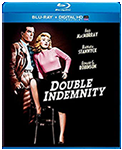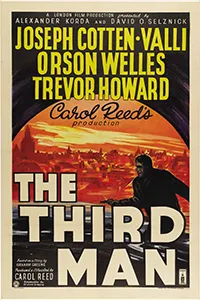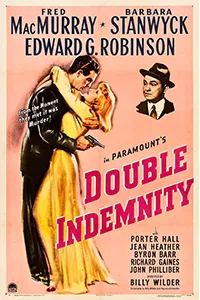THE NIGHT OF THE HUNTER
The Night of the Hunter is a chilling 1955 film noir directed by Charles Laughton. Set during the Great Depression, it follows the sinister Reverend Harry Powell, played by Robert Mitchum, as he hunts a widow and her children for hidden wealth. With its stark black-and-white cinematography and gripping narrative, the film explores themes of good versus evil, showcasing the struggle between innocence and malevolence. As Powell’s facade crumbles, tension builds, resulting in a desperate chase that captivates audiences. With unforgettable performances and a haunting atmosphere, “The Night of the Hunter” remains a timeless masterpiece of psychological suspense.

Director: Charles Laughton
Year: 1955
Stars: Robert Mitchum, Shelley Winters, Lillian Gish
PLOT
Set in a small West Virginia town during the Great Depression, the story revolves around the enigmatic and sinister character of Reverend Harry Powell, played by Robert Mitchum.
The film opens with a shot of the night sky and the chilling hymn “Leaning on the Everlasting Arms” setting the tone. We learn that Powell, a self-proclaimed preacher with the words “love” and “hate” tattooed on his knuckles, has recently been released from prison. Inside his cell, his cellmate Ben Harper, played by Peter Graves, shares a secret with him before his execution: he has hidden $10,000 somewhere.
Word of the hidden money spreads, and soon Reverend Powell arrives in town, posing as a man of God. He marries Harper’s widow, Willa, played by Shelley Winters, in hopes of discovering the money’s location. Willa’s two children, John and Pearl, are aware of their father’s secret, but they swear to keep it hidden.
As the story progresses, Powell’s true nature begins to unravel. He reveals his sadistic and manipulative side as he tries to charm and coerce the children into revealing the money’s location. Meanwhile, John, portrayed by Billy Chapin, becomes increasingly suspicious of the preacher’s intentions.
The film is notable for its powerful visual symbolism, such as the recurring motif of hands—both Reverend Powell’s tattooed hands and the children’s praying hands. Additionally, the use of light and shadow, accentuated by German expressionist influences, adds an atmospheric and eerie quality to the film.
Desperate to protect themselves and their father’s secret, John and Pearl embark on a perilous journey down the Ohio River, pursued by the relentless and malevolent Reverend Powell. Along the way, they encounter Rachel Cooper, a strong-willed and compassionate woman who becomes their protector and guiding light. Lillian Gish delivers a remarkable performance as Rachel Cooper, a guardian figure who embodies love and resilience in the face of evil.
The final confrontation between Powell and the children takes place in an abandoned cellar, where tension reaches its peak. The sequence is filled with suspenseful moments and showcases the film’s masterful use of lighting and shadows to heighten the psychological intensity.
THEMES
The movie explores themes of greed, lust, betrayal, and the corruptibility of the human soul.
One of the central themes of “Double Indemnity” is greed. Walter Neff, the protagonist, is initially portrayed as a hard-working, honest insurance salesman who takes pride in his job. However, he becomes increasingly consumed by his desire for wealth and luxury, which leads him to become complicit in the murder of Phyllis’s husband. The film depicts how the lure of money can corrupt even the most decent and principled individuals, leading them down a path of destruction.

Another prominent theme in the film is lust. Phyllis Dietrichson is a femme fatale, a character archetype common in film noir, who uses her beauty and charm to manipulate men for her own purposes. Neff is immediately smitten by Phyllis and is willing to do anything to win her affection, including murder. The film portrays how unchecked desire can lead people to commit terrible acts and destroy their own lives in the process.
Betrayal is another major theme in “Double Indemnity.” Phyllis’s husband trusts Neff and even confides in him about his marital problems, unaware that Neff is secretly having an affair with his wife. Neff’s betrayal of his friend and colleague, Barton Keyes (played by Edward G. Robinson), is also a significant plot point, as Keyes becomes increasingly suspicious of Neff’s involvement in the murder. The film depicts how trust and loyalty can be easily broken, leading to tragic consequences for all involved.
Finally, “Double Indemnity” explores the corruptibility of the human soul. The film suggests that no one is truly immune to the temptations of greed and lust, and that anyone can be pushed to commit immoral acts under the right circumstances. Neff and Phyllis are both portrayed as flawed individuals who are capable of both good and evil, and their actions have devastating consequences for themselves and those around them.
In conclusion, “Double Indemnity” is a complex and thought-provoking film that explores themes of greed, lust, betrayal, and the corruptibility of the human soul. The film’s characters are flawed and morally ambiguous, and their actions reflect the darker aspects of human nature. “Double Indemnity” remains a classic of the film noir genre and a testament to the enduring power of storytelling to illuminate the complexities of the human experience.
POPULAR CULTURE
Over the years, “Double Indemnity” has become a cultural touchstone, and its influence can be seen in various films, TV shows, and other media. Here are some examples:
The film “Body Heat” (1981) is often cited as a modern-day retelling of “Double Indemnity.” Like the earlier film, it involves a man who becomes entangled with a dangerous woman and gets drawn into a murder plot.
In the TV show “The Simpsons,” there is an episode called “Double, Double, Boy in Trouble” (2007) that references “Double Indemnity” in its title and plot. In the episode, Bart and Lisa suspect that their babysitter is trying to murder their parents for the insurance money.
The song “Phyllis” by the band Let’s Active references the character of Phyllis Dietrichson in its lyrics.
In the film “Basic Instinct” (1992), Sharon Stone’s character is often compared to Phyllis Dietrichson for her seductive and dangerous nature.
The video game “LA Noire” (2011) features a case called “The Silk Stocking Murder,” which is heavily inspired by “Double Indemnity.” The case involves a murder-for-insurance plot and a femme fatale who tries to manipulate the main character.
Explore more Film Noir

Classic film noir set in post-WWII Vienna, where a writer investigates the mysterious death of his friend.

A gripping film noir about a seductive woman who convinces an insurance salesman to plot a murder.

This classic film noir follows private detective Philip Marlowe as he investigates a complex case involving a wealthy family.